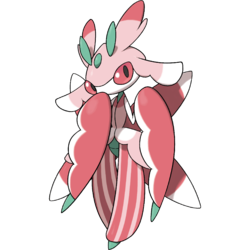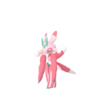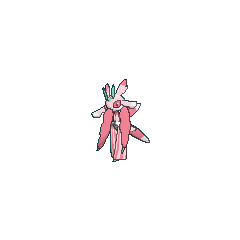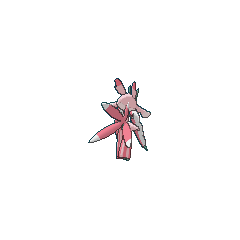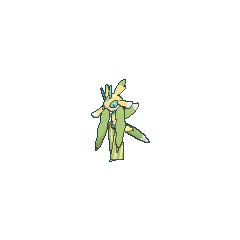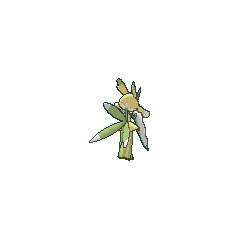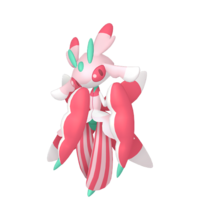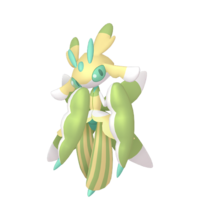From Bulbapedia, the community-driven Pokémon encyclopedia.
|
|
| Line 321: |
Line 321: |
| {{Spritebox/NA|gen=VII}} | | {{Spritebox/NA|gen=VII}} |
| {{Spritebox/7|ndex=754|crop=84}} | | {{Spritebox/7|ndex=754|crop=84}} |
| {{Spritebox/8|ndex=754}} | | <!--{{Spritebox/8|ndex=754}} |
| {{Spritebox/9|ndex=0754}} | | {{Spritebox/9|ndex=0754}}--> |
| {{Spritebox/HOME|ndex=0754}} | | {{Spritebox/HOME|ndex=0754}} |
| {{Spritebox/Footer|754|Lurantis}} | | {{Spritebox/Footer|754|Lurantis}} |
Revision as of 00:12, 29 December 2023
Lurantis (Japanese: ラランテス Lalantes) is a Grass-type Pokémon introduced in Generation VII.
It evolves from Fomantis when leveled up in the day starting at level 34.
Biology
Lurantis is a plantlike Pokémon that resembles an insect. The top half of its head is light pink, while the bottom half is white. It has light red eyes, and two green antennae with a small green lump between them. There are four extensions to the top half of its head: two on the top with red tips that resemble ears, and one on each side with white tips that resemble stylized hair. It has a light pink body with wavy, skirt-like extensions around the waist and a green abdomen and neck. Its thin, white arms end in large, red scythes with white along the bottom rim and a single green claw on the tip. There are vertical, pink-and-red stripes down its legs, which have small, pointed green feet. The coloring and shape of Lurantis's body and arms give it the appearance of wearing a long-sleeved dress, while its legs are similar to pants. Four red, wing-like appendages sprout from its back, each tipped with white.
Lurantis both looks and smells like a flower, a trait that it exploits to lure foes in for a surprise attack. Its brilliant coloration and elegant moves have earned it acclaim as the most glamorous Grass-type Pokémon. However, it does disguise itself as a Bug Pokémon for protection. Maintaining its appearance requires detailed grooming. If a Trainer does a good job caring for it, Lurantis will have an easier time trusting them than a lazy Trainer and have gorgeous, brilliant colors.[1]
By gathering light, Lurantis can fire laser beams using its sickle-like arms. These beams can cleave metal plates. In Generation VII, Solar Blade was its signature move.
Evolution
Lurantis evolves from Fomantis.
(For specifics on this Pokémon's evolution in the games, refer to Game data→Evolution data.)
In the anime
Major appearances
A Totem Lurantis debuted in Currying Favor and Flavor!, where it challenged Ash in the Lush Jungle trial. It was eventually defeated by Litten. Afterwards, it awarded Ash with a Grassium Z.
A Lurantis appeared in The Power of Us, under the ownership of Toren.
In Suffering the Flings and Arrows!, Jessie pulled a Lurantis from the Rocket Prize Master.
Minor appearances
A Trainer's Lurantis appeared in Guzma's flashback in The Wisdom Not to Run!.
Pokédex entries
| Episode
|
Pokémon
|
Source
|
Entry
|
| SM035
|
Lurantis
|
Rotom Pokédex
|
Lurantis, the Bloom Sickle Pokémon. A Grass type, and the evolved form of Fomantis. Lurantis use their flower-like appearance and aroma to lure in opponents and defeat them.
|
|
In the manga
Pokémon Adventures
A Totem Lurantis debuted in Flash and Cosmog's Secret. In order to get strong enough to face the Ultra Beasts threatening to invade Alola, Moon summoned Lurantis to Konikoni City with a soup made by Mallow and battled it as a form of training. Despite the assistance of many ally Pokémon, Lurantis was eventually defeated by Moon's Mareanie.
Pokémon Horizon
A Lurantis appeared in a fantasy in Journey to a New Horizon.
In the TCG
- Main article: Lurantis (TCG)
Game data
Pokédex entries
| This Pokémon was unavailable prior to Generation VII.
|
| Generation VII
|
|
Alola
SM: #144
|
|
Alola
USUM: #177
|
|
Kanto
#—
|
| This Pokémon has no Pokédex entries in Let's Go, Pikachu! and Let's Go, Eevee!.
|
| Sun
|
It requires a lot of effort to maintain Lurantis's vivid coloring, but some collectors enjoy this work and treat it as their hobby.
|
| Moon
|
It fires beams from its sickle-shaped petals. These beams are powerful enough to cleave through thick metal plates.
|
| Ultra Sun
|
For self-protection, it pretends to be a bug Pokémon. Both of its arms bear keen-edged petals.
|
| Ultra Moon
|
As it slashes into its enemies, it looks like it's dancing. Its elegant appearance has led some to call it the most glamorous Grass Pokémon.
|
|
|
| Generation VIII
|
|
Galar
Isle of Armor #018
|
|
Sinnoh
#—
|
|
Hisui
#—
|
| This Pokémon has no Pokédex entries in Brilliant Diamond, Shining Pearl, and Legends: Arceus.
|
| Sword
|
This Pokémon resembles a beautiful flower. A properly raised Lurantis will have gorgeous, brilliant colors.
|
| Shield
|
The petals on this Pokémon's arms are thin and super sharp, and they can fire laser beams if Lurantis gathers light first.
|
|
|
| Generation IX
|
|
Paldea
#248
|
|
Kitakami
#32
|
|
Blueberry
#—
|
| Scarlet
|
By masquerading as a bug Pokémon, it lowers the guard of actual bug Pokémon lured in by a scent of sweet flowers. Its sickles bring them down.
|
| Violet
|
A lot of time and effort is required to maintain the vivid colors of its petals. This Pokémon puts its Trainer's attentiveness to the test.
|
|
|
Game locations
| This Pokémon was unavailable prior to Generation VII.
|
|
|
|
|
|
|
In side games
| This Pokémon was unavailable prior to Generation VII.
|
| Generation VII
|
|
| This Pokémon is unavailable in Generation VII side games.
|
|
|
| Generation VIII
|
|
| This Pokémon is unavailable in Generation VIII side games.
|
|
|
|
|
Stats
Base stats
| Stat
|
Range
|
| At Lv. 50
|
At Lv. 100
|
70
|
|
130 - 177
|
250 - 344
|
105
|
|
99 - 172
|
193 - 339
|
90
|
|
85 - 156
|
166 - 306
|
80
|
|
76 - 145
|
148 - 284
|
90
|
|
85 - 156
|
166 - 306
|
45
|
|
45 - 106
|
85 - 207
|
Total: 480
|
Other Pokémon with this total
|
- Minimum stats are calculated with 0 EVs, IVs of 0, and (if applicable) a hindering nature.
- Maximum stats are calculated with 252 EVs, IVs of 31, and (if applicable) a helpful nature.
|
Type effectiveness
| Under normal battle conditions in Generation IX, this Pokémon is:
|
|
|
|
|
|
|
|
|
|
|
|
|
Learnset
|
|
|
|
- Bold indicates a move that gets STAB when used by Lurantis
- Italic indicates a move that gets STAB only when used by an Evolution of Lurantis
- Click on the generation numbers at the top to see level-up moves from other generations
|
|
|
|
|
- Bold indicates a move that gets STAB when used by Lurantis
- Italic indicates a move that gets STAB only when used by an Evolution or an alternate form of Lurantis
- Click on the generation numbers at the top to see TM moves from other generations
|
|
|
|
|
- Moves marked with an asterisk (*) must be chain bred onto Lurantis
- Bold indicates a move that gets STAB when used by Lurantis
- Italic indicates a move that gets STAB only when used by an Evolution of Lurantis
|
|
|
|
|
- Bold indicates a move that gets STAB when used by Lurantis
- Italic indicates a move that gets STAB only when used by an Evolution of Lurantis
|
Side game data
Evolution data
Sprites
| This Pokémon was unavailable prior to Generation VII.
|
|
|
|
|
Trivia
Origin
Lurantis may be based on the orchid flower, along with the orchid mantis, reversing the mimetic relationship between those two organisms. Its appearance also resembles a kimono.
Name origin
Lurantis may be a combination of lure, allure, fleur (French for flower), and mantis.
Lalantes may be a combination of 蘭 ran (orchid) and a corruption of mantis.
In other languages
| Language
|
Title
|
Meaning
|
 Japanese Japanese
|
ラランテス Lalantes
|
From 蘭 ran and a corruption of mantis
|
 French French
|
Floramantis
|
From flora and mantis
|
 Spanish Spanish
|
Lurantis
|
Same as English name
|
 German German
|
Mantidea
|
From Mantis and dea
|
 Italian Italian
|
Lurantis
|
Same as English name
|
 Korean Korean
|
라란티스 Rarantis
|
Transliteration of Japanese name
|
 Mandarin Chinese Mandarin Chinese
|
蘭螳花 / 兰螳花 Lántánghuā
|
From 蘭花 / 兰花 lánhuā and 螳螂 tángláng or 蘭花螳螂 / 兰花螳螂 lánhuā tángláng
|
 Cantonese Chinese Cantonese Chinese
|
蘭螳花 Làahntòhngfā
|
From 蘭花 làahnfā and 螳螂 tòhnglòhng or 蘭花螳螂 làahnfā tòhnglòhng
|
|
|
|
| More languages
|
 Russian Russian
|
Лурантис Lurantis
|
Transcription of English name
|
 Thai Thai
|
รารันเทส Raranthet
|
Transcription of Japanese name
|
|
|
|
Related articles
References
External links

|
This Pokémon article is part of Project Pokédex, a Bulbapedia project that aims to write comprehensive articles on each Pokémon species, as well as Pokémon groups and forms.
|

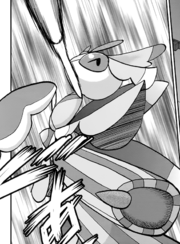
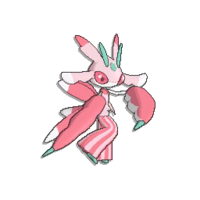
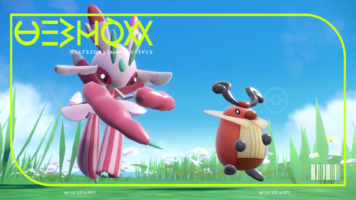

 For other sprites and images, please see Lurantis images on the Bulbagarden Archives.
For other sprites and images, please see Lurantis images on the Bulbagarden Archives.
